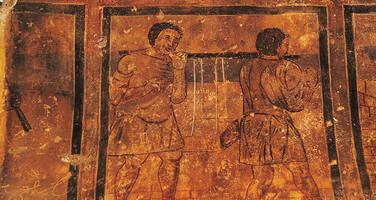Quseir Amra
Factors affecting the property in 1998*
- Ground transport infrastructure
- Interpretative and visitation facilities
- Management systems/ management plan
Factors* affecting the property identified in previous reports
- cracks in the rough-rendered surface of the vaults
- water infiltrations
- graffitis
- signs (for visitors) disfiguring the interior
- flooding (issue resolved)
- need to improve visitor control mechanisms
International Assistance: requests for the property until 1998
Total amount approved : 40,000 USD
| 1998 |
Visitors' Centre at Quseir Amra (NOT IMPLEMENTED)
(Approved)
Reapproval: 08 Jan, 1999 (n°1058 - 20,000 USD)
|
20,000 USD |
| 1995 | Urgent works on the site of Quseir Amra (Approved) | 20,000 USD |
Missions to the property until 1998**
Information presented to the Bureau of the World Heritage Committee in 1998
In December 1997 the same mission visited Quseir Amra. At the site, the members of the mission found that the highway recently constructed was within the boundaries of the site and that other inappropriate constructions had also been built alongside the boundaries. As for the proposed new Visitors’ Centre, the mission suggested that the location be reconsidered in order not to threaten the landscape of the site, being an isolated monument too close to the Baths.
Action Required
Conservation issues presented to the World Heritage Committee in 1998
In August 1998, the Centre received a letter from the Director-General of the Antiquities in Jordan stating that the Jordanian authorities in co-operation with IFAPO had already completed the alternative plan of the Visitors’ Centre at Quseir Amra. The proposed location is East of the ancient Roman bath within the fenced area and at a good distance from the monument. The Director-General of the Antiquities also stated in his letter that the idea to divert the Visitors’ Centre to the other side of the highway would be unrealistic and would threaten the safety of the visitors in crossing the highway.
The Centre requested the authority to send a detailed plan to be forwarded to ICOMOS for evaluation.
After having taken note of the report of the Secretariat and the evaluation of ICOMOS, the Bureau endorsed the views of the Jordanian authorities concerning the location of the Visitors’ Centre. However, it requested the authorities to do their utmost to minimize the impact of the Visitors’ Centre on the landscape and to provide the Secretariat with a proposal in this respect. Moreover, the Bureau requested the Jordanian authorities to continue preserving works of the mural paintings of the Roman bath.
Summary of the interventions
Decisions adopted by the Committee in 1998
22 BUR V.B.48
Quseir Amra (Jordan)
After having taken note of the report of the Secretariat, the Bureau requested the Jordanian authorities to reconsider the proposed location of the Visitors’ Centre because of its excessive visibility and proximity to the monument. Furthermore, the Bureau also requested the authorities to study the possibility of diverting the present road.
22 COM VII.43
Reports on the State of Conservation of Cultural Properties Noted by the Committee
VII.43 The Committee noted the decisions of the twenty-second extraordinary session of the Bureau as reflected in the Report of the Bureau session (Working Document WHC-98/CONF.203/5) and included in Annex IV of this report on the following properties:
Rapa Nui National Park (Chile)
The Mountain Resort and Its Outlying Temples in Chengde (China)
The Potala Palace, Lhasa (China)
Temple and Cemetery of Confucius and the Kong Family Mansion in Qufu (China)
Ancient Building Complex in the Wudang Mountains (China)
City of Quito (Ecuador)
Memphis and its Necropolis - the Pyramid Fields from Giza to Dahshur (Egypt)
Ancient Thebes with its Necropolis (Egypt)
Islamic Cairo (Egypt)
Historic Centre (Old Town) of Tallinn (Estonia)
Collegiate Church, Castle and Old Town in Quedlinburg (Germany)
Historic Centre of Florence (Italy)
Quseir Amra (Jordan)
Luang Prabang (Laos)
Baalbek (Lebanon)
Tyre (Lebanon)
Vilnius Historic Centre (Lithuania)
Old Towns of Djenné (Mali)
City of Cusco (Peru)
Archaeological site of Chavin (Peru)
Historic Centre of Lima (Peru)
The Baroque Churches of the Philippines (The Philippines)
Historic Centre of Porto (Portugal)
Island of Gorée (Senegal)
Sacred City of Anuradhapura (Sri Lanka)
Ancient City of Polonnaruva (Sri Lanka)
Ancient City of Sigiriya (Sri Lanka)
Site of Palmyra (Syrian Arab Republic)
Historic Areas of Istanbul (Turkey)
Kiev: Saint Sophia Cathedral and Related Monastic Buildings (Ukraine)
Complex of Hué Monuments (Vietnam)
Old City of Sana'a (Yemen)
No draft Decision
Exports
* :
The threats indicated are listed in alphabetical order; their order does not constitute a classification according to the importance of their impact on the property.
Furthermore, they are presented irrespective of the type of threat faced by the property, i.e. with specific and proven imminent danger (“ascertained danger”) or with threats which could have deleterious effects on the property’s Outstanding Universal Value (“potential danger”).
** : All mission reports are not always available electronically.


